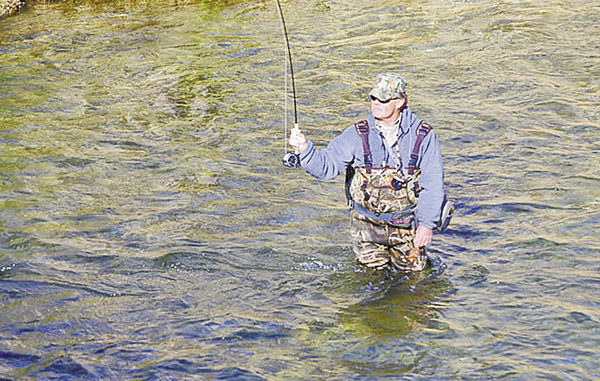
Long before the first settlers arrived in Western North Carolina mountains, and long before “gentlemen” fly fishers discovered the fine trout waters of the Southern Appalachians, the Cherokee were using flies to catch trout, not for sport, but for food.
According to Jan Davidson, director of the John C. Campbell Folk School at Brasstown and an authority on trout fishing in the mountains, the Cherokee were the first master fly anglers in the mountains. The Cherokee fashioned hooks from chipped stone and the leg bones of deer. They wrapped the shanks of the hooks with deer hair and fished them wet, catching the abundant brook trout that, until the late 1800s, were the only salmonids in mountain streams.
Early settlers continued the fly-fishing tradition, adapting and modifying the Cherokee deer-hair fly and creating their own flies. One version of that early fly evolved into a popular fly called the Irresistible, which is still used today.
Other “traditional” mountain patterns evolved much later — some out of need, some out of opportunity. Probably one of the most famous traditional mountain flies is the Yellowhammer, or “Yallerhammer,” as it was more commonly called. This fly, according to Roger Lowe, a master fly-tier from Waynesville, is “a very effective fly, one of the first flies to come to mind when you think about fishing Western North Carolina streams” primarily because many mountain anglers believed that a fly with a little “yaller” in it would attract more trout.
No one is certain who originated the Yellowhammer, although Davidson speculates that the Cherokee may have tied the first one, wrapping the bright quills of the yellow-shafted flicker around a hook reverse-palmer style. After the flicker became endangered, fly tiers switched to other materials, dyeing grizzly hackle and peacock or dove feathers to resemble the bright yellow plumage of the flicker.
One of the people most often associated with the Yellowhammer was the late Fred Hall of Bryson City. Hall and his wife, Alleen, turned out thousands of Yellowhammers, along with a variety of other patterns, for local and visiting fly fishers. Some people give Hall credit for originating the Tellico nymph and the Adams variant.
The Yellowhammer was tied as both a wet and dry fly; sometimes it was tied on a straight-eyed hook and fished as a nymph. Another early practice, Lowe said, was to attach a willowleaf spinner to the Yellowhammer and use it as a spinner. That was a practice favored by old-timers and used long before Rooster Tail and Mepps spinners became available, Lowe said.
Another Fred Hall original was the Thunderhead, a fly especially designed for the rough-water streams in the Smokies. The fly floats well and is a good attractor pattern. Some fly fishers use this fly year-round, varying the size to fit the fishing conditions. It’s easy to see in the water because of its hair wings, Lowe said.
One fly that traditional fly fishers always kept in their fly box is the Gray Hackle, a yellow-bodied fly with grizzly hackle and tail but no wings. Some fly fishers added a red feather to the tail, and a few enterprising ones with more ingenuity than money used the red cellophane strip from a cigarette pack for a tail.
The Gray Hackle and the Tellico Nymph were two patterns than fitted the widest variety of fishing conditions, and if you didn’t have those two flies, you didn’t catch fish.
Some patterns evolved from patterns created by other fly-tiers. The Tennessee Wulff, for example, is a variation of Lee Wulff’s famous Royal Wulff. The mountain version has a green center instead of a red center.
Other traditional favorites are the pale Yellow Palmer, a fly favored for the streams in the Little Cataloochee area; the Jim-Charley, a local pattern used on the Big East Fork of the Pigeon River and on the Davidson River; the Smoky Mountain Forked-Tail, which has mallard wings, blue dun hackle, orange body, and a forked tail of mallard feathers; the Coffey Stone Nymph, originated by Frank Coffey of Maggie Valley and utilizing scrap material from the Waynesville Dayco plant; the Secret Weapon, which was used by mountain fly fishers long before the popular Prince fly came into use; and the Horse Hair Nymph, which simulates a hellgrammite.
New patterns come and go, but the traditional patterns are the flies that consistently catch the most trout.
Terrestrials are effective flies for summer fishing. Recommended are No. 14 for inch worms, No. 16 for black ants and beetles, and No. 12 for crickets and hoppers. Midge patterns also are good bets this time of year. These gnat-like insects hatch year-round. Small is best: Nos. 24 through 26. If you have trouble seeing a fly that small, use a larger dry-fly dropper as a strike indicator. Tie the smaller fly to the larger fly’s shank, using about one-foot of tippet. This technique also works well for nymph fishing. The larger dry fly will keep small Hare’s Ear, Tellico, or Pheasant Tail nymphs suspended in the water.




Be the first to comment